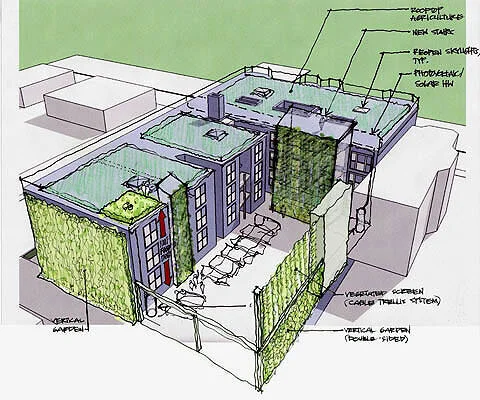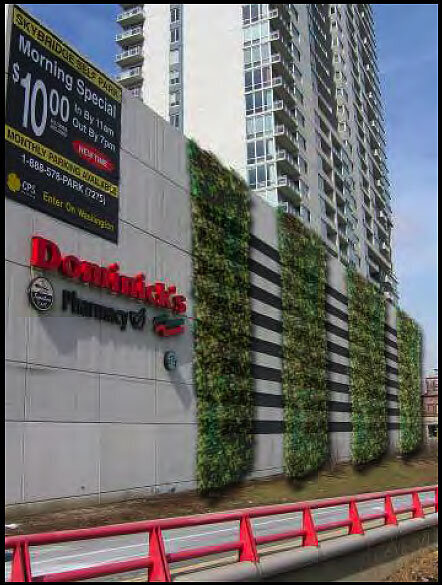VERTICAL GARDENS INITIATIVE
Vertical gardens have the power to capture the imagination more than any other sustainable design element: they seem to defy gravity and logic, link us to our arboreal forest origins, and introduce beauty into our cities.
Benefits
Aside from being beautiful, reconnecting us with our origins as a species, and speaking to our inherent biophilic nature (the love of living, growing things), vertical gardens may also:
Provide hyper-local food
Improve air quality, stormwater control
Combat the Urban Heat Island Effect (UHIE)
Help mitigate sound pollution
Reduce energy demand on buildings due to shading / introduction of microclimate
Reduce the maintenance on surfaces of buildings exposed to inclement weather
Stimulate secondary and tertiary economies
(Ex.: hire people to design them, install them, maintain them, harvest food from them, sell it, even people to monitor their beneficial effects)Connect disadvantaged and/or ‘captive’ populations with living things that need and love people (Ex.: elderly, patients, convalescents, students, ex-offenders.
Increase local and regional biodiversity
Logistics
Any successful vegetated wall, whether interior or exterior, will have, at minimum:
Internal irrigation
Good drainage
Access for regular maintenance
Adequate support structure
Having a water line and drainage line nearby is not essential, but a real plus.
Interior walls always require good waterproofing detailing to keep the vertical garden from impacting adjoining construction (i.e. keep the walls, floors, and ceiling under and around dry!) and often require supplemental light and good ventilation.
Costs
$60-160 per square foot is generally a good range for commercially-available, modular exterior vegetated wall systems.
This would include basic internal irrigation, plants, and costs of installation, and likely not include maintenance plan or plant replacement costs, and not include support structure (i.e. a wall) for the vertical garden.
This pricing is also not for highly customized works of art such as Patrick Blanc’s wonderful monolithic installations such as at Musee Quai Branly, Paris.
Rendering: Nicholas Petty
Design ideas and locations
We can do anything, anywhere.
Really.
The sky is, literally, the limit.
Examples for locations to install vertical gardens include:
A. Exterior
1. Parking decks
2. CTA, Metra, and bridge or traffic embankments (for beauty, sustenance, and even sound control)
3. Bus and train stops
4. Parking lots adjoining blank walls
5. Cemetary walls
6. Convalescent, assisted living, and “rest” homes
7. Hospitals and clinics
8. Fire and police stations
9. Libraries
10. Blank faces of buildings such as:
Schools (esp. gymnasium), park district fieldhouse, ugly new condos, industrial corridors, warehouses, power plants, storage facilities, grocery stores, pharmacies, big-box retail… etc.
11. Businesses that deal with plants, landscaping materials, and other green and eco- stuff already.
B. Interior
1. Corporate and hotel lobbies and atriums
2. Restaurants
3. Big-box retail (Home Depot, Target, Walmart)
4. Convalescent, assisted living, and “rest” homes
5. Hospitals and clinics
6. Offices
7. Elementary, secondary, vocational school, and university buildings (lobbies, atriums, student commons, cafeterias)
Find any moderate-sized, blank area.
Pick places that are highly visible eyesores, or places where people naturally congregate.
Use vertical gardens to reconnect and reinvigorate!
Installation in the “Liquid House” exhibit at Discovery World, Milwaukee, IL.
Experience: What Urban Habitat Chicago is doing
We have a talented team that includes architects, engineers, consultants, a great network of contacts with providers and installers, and the most talented biological designer in the Midwest!!
PAST PROJECTS
Members of our team have done valuable groundwork for years to advance the viability of vertical gardens.
Examples include:
Photo: Michael Repkin
“Liquid House” exhibit installation
Location: Milwaukee, IL
Installation type: interior, permanent
Manufacturer, wall system type: Repkin Biosystems, custom
Designer: Michael Repkin, Repkin Biosystems
Architectural detailing: Dave Hampton, Hampton Avery Architects
Client: Discovery World Museum
Vegetated area: 250 sf
Completed: 2008
Photos: Dave Hampton
“Living Canvas” exhibit installation in “Act Natural” show
Location: Chicago, IL
Installation type: interior, temporary (April-May 2008)
Manufacturer, wall system type: Repkin Biosystems, custom
Designer: Michael Repkin, Repkin Biosystems
Client: 32nd and Urban Gallery
Vegetated area: 50 sf
Completed: 2008
FUTURE PROJECTS
Rendering: Dave Hampton
Sunlight of the Spirit Recovery Gardens
Scope: Design and installation of vegetated walls at 36-unit residential building with food pantry serving 800 families per week.
Location: 3200 W. Fulton / 306 N. Kedzie, Chicago, IL
Installation type: exterior, permanent
Manufacturer, wall system type: TBD
Designer: Urban Habitat Chicago
Client: Sunlight of the Spirit
Vegetated area: 1300 SF (Phase I), 2240 SF (Phase II)
Targeted completion date: Fall 2010 (Phase I), Winter 2011 (Phase II)
Read more about the Sunlight of the Spirit Recovery Gardens here.
Rendering: Nicholas Petty
48th Ward Vertical Gardens
Scope: design consultation - working with Alderman Maryanne Smith’s office to pinpoint possible locations for vertical gardens
Locations: various, TBD
Installation type: exterior, permanent
Manufacturer, wall system type: TBD
Designer: Urban Habitat Chicago
Client: 48 Ward Alderman Maryanne Smith
Vegetated area: TBD
Targeted completion date: TBD
Learn more
UHC Lecture Series 2009, 3. Vertical Is The New Horizon
Lecturer: Nicholas Petty, MLA
Date/time: Wednesday, March 4th, 2009 at 7:00pm
Vertical Is The New Horizon.pdf (4.5 MB, PDF format)







